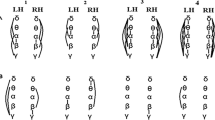Objectives. To study interhemispheric asymmetry (IHA) by electroencephalography (EEG) in healthy subjects during cognitive waking from stage II daytime sleep prior to recovery of the performance of a psychomotor test. Materials and methods. IHA of the amplitude-amplitude coupling of EEG rhythms was studied in healthy adult subjects using 20-sec trace segments recorded in the state preceding spontaneous waking, as defined by the moment the α rhythm appeared on the EEG, and the subsequent onset of psychomotor activity. The state of subjects during this period (the initial stage of so-called cognitive waking preceding behavioral waking), when theperson is unable to movebut is able to perceive external stimuli, is an experimental model for identifying signs of conscious activity in patients coming out of coma. Wavelet transformation was used to compute the rhythmic characteristics of bioelectrical activity. The Kendall correlation coefficient served as a measure of interactions between rhythms. Results. IHA of the interaction of EEG rhythms was found to be dynamic in nature and to be formed due to the connections of the θ rhythm with the α2 and β rhythms in the left hemisphere of the brain and δ–θ connections in the right. Conclusions. The marked left-hemisphere asymmetry is probably associated with the onset of the retrieval of instructions from memory, which subsequently allows return to the activities interrupted by sleep.
Similar content being viewed by others
References
M. A. Koenig and P. W. Kaplan, “Clinical neurophysiology in acute coma and disorders of consciousness,” Semin. Neurol., 33, 121–132 (2013), https://doi.org/10.1055/s-0033-1348962.
X. G. Kang, F. Yang, W. Li, et al., “Predictive value of EEG-awakening for behavioral awakening from coma,” Ann. Intensive Care, 5, No. 52, 1–8 (2015), https://doi.org/10.1186/s13613-015-0094-4.
W. Chen, G. Liu, Y. Su, et al., “EEG signal varies with different outcomes in comatose patients: a quantitative method of electroencephalography reactivity,” J. Neurosci. Meth., 342, No. 30, 108812 (2020), https://doi.org/10.1016/j.jneumeth.2020.108812.
Sharova, A. A. Ogurcova, and K. N. Lapteva, “The EEG in the early postoperative period,” in: Neurophysiological Investigations in the Clinic, Burdenko National Medical Neurosurgery Research Center, Moscow (2019), 2nd ed., pp. 150–166.
E. A. Cheremushkin, N. E. Petrenko, M. S. Gendzhalieva, et al., “EEG characteristics in the process of transient spontaneous wakings of different durations on alterations in psychomotor activity due to falling asleep,” Ros. Fiziol. Zh., 106, No. 3, 342–355 (2020), 10.31857/S0869813920030036.
U. Voss, “Change in EEG pre and post awakening,” Int. Rev. Neurobiol., 93, 23–55 (2010), https://doi.org/10.1016/S0074-7742(10)93002-X.
Cherkasova, K. A. Yatsko, M. S. Kovyazina, et al., “Development of paradigms for the diagnosis of ‘covert cognition’ and cognitive motor dissociation in patients with chronic disorders of consciousness,” Fizich. Reabilits. Med., 3, No. 3, 318–321 (2021), 10.36425/rehab72308.
E. V. Sharova, O. S. Zaitsev, E. V. Korobkova, et al., “Analysis of behavioral and EEG correlatives of attention in the dynamics of recovery of consciousness following severe brain injury,” Nevrol. Neiropsikh. Psikhosom., 8, No. 3, 17–25 (2016).
M. Casagrande and M. Bertini, “Night time right hemisphere superiority and daytime left hemisphere superiority: a repatterning of laterality across wake–sleep–wake states,” Biol. Psychol., 77, No. 3, 337–342 (2008), https://doi.org/10.1016/j.biopsycho.2007.11.007.
V. B. Dorokhov, “Alpha-spindle and K-complex – phase activation patterns during spontaneous recovery of psychomotor activity disorders at different stages,” Zh. Vyssh. Nerv. Deyat., 53, No. 4, 502–511 (2003).
M. H. Bonnet, D. W. Carley, and M. A. Carskadon, “EEG arousals: scoring rules and examples: a preliminary report from the Sleep Disorders Atlas Task Force of the American Sleep Disorders Association,” Sleep, 15, No. 2, 173–184 (1992), https://doi.org/10.1093/sleep/15.2.173.
C. Tallon-Baudry, O. Bertrand, F. Peronnet, et al., “Induced gamma band activity during the delay of a visual short term memory task in humans,” J. Neurosci., 18, No. 11, 4244–4254 (1998), https://doi.org/10.1523/JNEUROSCI.18-11-04244.1998.
E. I. Rodriguez-Martinez, C. I. Barriga-Paulino, M. A. Rojas-Benjumea, et al., “Co-maturation of theta and low-beta rhythms during child development,” Brain Topogr., 28, 250–260 (2015), https://doi.org/10.1007/s10548-014-0369-3.
R. Perrine, M. Eskinazi, R. Bouet, et al., “Dynamics of hippocampus and orbitofrontal cortex activity during arousing reactions from sleep: An intracranial electroencephalographic study,” Hum. Brain Mapp., 42, No. 1, 1–16 (2021), https://doi.org/10.1002/hbm.25609.
D.-H. Park and C.-J. Shin, “Asymmetrical electroencephalographic change of human brain during sleep onset period,” Psychiatry Investig., 14, No. 6, 839–843 (2017), https://doi.org/10.4306/pi.2017.14.6.839.
L. A. Zhavoronkova, Interhemispheric Asymmetry of the Human Brain (right-handed, left-handed), Yurait, Moscow (2019), 3rd ed.
Author information
Authors and Affiliations
Corresponding author
Additional information
Translated from Zhurnal Nevrologii i Psikhiatrii imeni S. S. Korsakova, Vol. 122, No. 5, Iss. 2, pp. 18–22, May, 2022.
Rights and permissions
Springer Nature or its licensor (e.g. a society or other partner) holds exclusive rights to this article under a publishing agreement with the author(s) or other rightsholder(s); author self-archiving of the accepted manuscript version of this article is solely governed by the terms of such publishing agreement and applicable law.
About this article
Cite this article
Yakovenko, I.A., Petrenko, N.E., Cheremushkin, E.A. et al. Interhemispheric Asymmetry of Connections of EEG Rhythms on Spontaneous Waking after Transient Episodes of Sleep while Performing a Monotonous Psychomotor Test. Neurosci Behav Physi 53, 12–15 (2023). https://doi.org/10.1007/s11055-023-01384-x
Received:
Accepted:
Published:
Issue Date:
DOI: https://doi.org/10.1007/s11055-023-01384-x




